#Christ Blessings in a Modern Fresco
Text
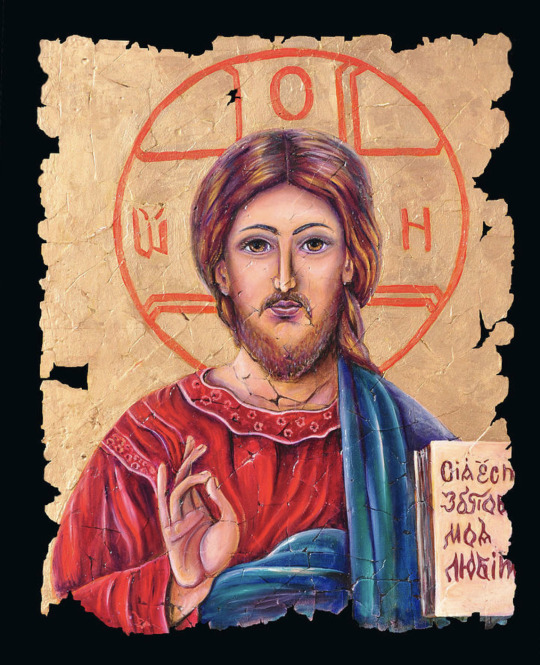
Christ Blessings in a Modern Fresco
https://fineartamerica.com/featured/christ-blessings-in-a-modern-fresco-olena-art.html?newartwork=true A mesmerizing artwork depicting the spiritual essence and kindness inspired by the sacred icon of Christ. 🕊️✍️ Immerse yourself in the depths of beauty and spiritual tranquility this artwork offers, experiencing the divine presence and eternal blessings. 🌟💖 #Jesus #Jesusicon #Jesusfresco #ArtInspiration #SpiritualJourney #RussianSoul #EternalBlessing #ArtInspiration, #SpiritualJourney, #RussianSoul, #EternalBlessing, #DivineGuidance, #SacredArt, #BeautyInArt, #Spirituality, #Kindness, #InspiredByFaith, #SoulfulCreation, #IconicInspiration, #BrushstrokesOfDivinity, #ArtisticSpirit, #olenaart #EternalPresence @FineArtAmerica @FineArtAmerica @Shoppixels @Shoppixels
#Christ Blessings in a Modern Fresco#experiencing the divine presence and eternal blessings. 🌟💖#Jesus#Jesusicon#Jesusfresco#ArtInspiration#SpiritualJourney#RussianSoul#EternalBlessing#DivineGuidance#SacredArt#BeautyInArt#Spirituality#Kindness#InspiredByFaith#SoulfulCreation#IconicInspiration#BrushstrokesOfDivinity#ArtisticSpirit#olenaart#EternalPresence @FineArtAmerica @FineArtAmerica @Shoppixels @Shoppixels
2 notes
·
View notes
Text
Saint of the Day – 22 August – Blessed Giacomo Bianconi OP (1220-1301) – Dominican Priest and Friar, Confessor, Spiritual Advisor, founder and restorer of convents and churches – born on 7 March 1220 at Mevania (modern Bevagna), diocese of Spoleto, Umbria, Italy and died on 22 August 1301 at Mevania, Italy of natural causes. He is also known as Blessed James Bianconi.

Blessed Giacomo was born in Bevagna and was received into the Dominican Order at Spoleto in 1236. After his ordination, he devoted his energies to the eradication of the heresy of the Nicolaites from Umbria and finally succeeded in converting its chief propagator, Ortinellus. He became Provincial Minister in 1281 and was elected Prior of the Dominican convents in Spoleto, in 1291 and Foligno, in 1299.
Blessed Giacomo was prominent in providing aid to refugees from Bevagna after the Emperor Frederick II sacked the city in 1249. He was subsequently active in the rebuilding of the town, which culminated in the rebuilding of Palazzo dei Consoli in 1270. In 1291, he received permission to rebuild the church of San Giorgio in Bevagna and to construct the adjoining convent. He also established two nunneries in Bevagna – Santa Lucia and Santa Margherita. Towards the end of his life, he also served as Lector at San Domenico, Orvieto, where he acted as the spiritual advisor of the Blessed Jane of Orvieto. This Church is now renamed as Sts Domenico & Giacomo.
These two statues below, which are thought to have been bought by the Blessed Giacomo in Perugia, were moved from in Sts Domenico & Giacomo to the Pinacoteca in 2016:
✴a figure of the Madonna and Child; and
✴a wooden Crucifix. Once, as he prayed before it because he was experiencing doubts about his salvation, blood spurted from the image and he heard Christ saying: “This blood is the sign of your salvation”.
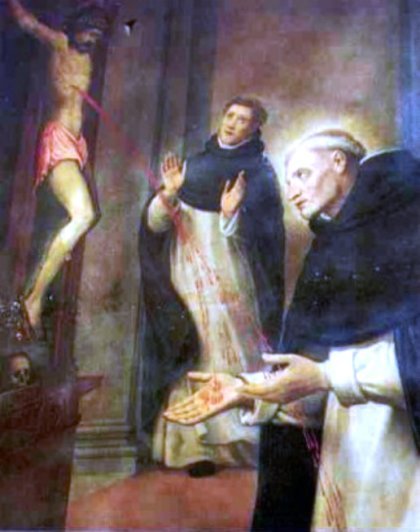
Both statutes were recorded in the 17th century the Cappella del Crocifisso at SS Domenico & Giacomo, which belonged to the Antici family.
After a life of extraordinary austerity, Giacomo died in Bevagna. Sts George and Dominic appeared to him as he died, in order to reward him for the honour that he had shown to them during his life.
When the Blessed Giacomo died in 1301, he was buried in San Giorgio.
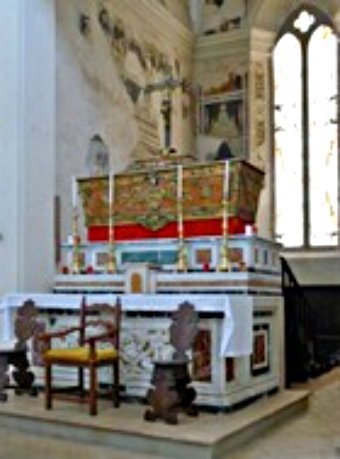
Miracles were reported at his grave and his relics were translated in 1302 into a sarcophagus that is now on the counter-facade of Sts Domenico & Giacomo, to the left of the entrance.
The Dominicans rebuilt San Giorgio in 1397 and re-dedicated it as Sts Domenico & Giacomo, probably as part of a bid for the canonisation of Giacomo Bianc oni. Pope Boniface IX granted indulgences to those who prayed before his relics during the first three days of May. Boniface IX granted similar indulgences in respect of Blessed Peter Crisci of Foligno. However, any early attempt to secure canonisation failed.
The relics were re-interred in 1589 in a new sarcophagus, as part of a fresh attempt to secure his beatification. This was adorned with painted scenes by Ascensidonio Spacca, il Fantino that depict the Blessed Giacomo.
Bishop Alfonso Visconti initiated a process for canonisation in 1608 but this was halted when he died soon after. Bishop Maffeo Barberini (later Pope Urban VIII) re-opened the case in 1612 and this led in 1632 to a formal process under three bishops, including Bishop Lorenzo Castrucci of Spoleto. This process was inconclusive and a second was needed before Urban VIII Beatified the Blessed Giacomo in 1641 . The frescoes in the cloister of the convent, which depict scenes from the life of the Blessed James, commemorate this event.
The death of Urban VIII in 1644 probably precluded the canonisation of the Blessed Giacomo. Yet another process was instituted in 1658 and Pope Clement X confirmed the cult in 1672. The relics were finally translated to the gilded bronze urn on the high altar of SS Domenico & Giacomo in 1686. Blessed Giacomo’s praise can be read in the Roman martyrology on 22 August
Saint of the Day – 22 August – Blessed Giacomo Bianconi OP (1220-1301) Saint of the Day - 22 August - Blessed Giacomo Bianconi OP (1220-1301) - Dominican Priest and Friar, Confessor, Spiritual Advisor, founder and restorer of convents and churches - born on 7 March 1220 at Mevania (modern Bevagna), diocese of Spoleto, Umbria, Italy and died on 22 August 1301 at Mevania, Italy of natural causes.
8 notes
·
View notes
Photo

Noli Me Tangere , fresco by Fra Angelico
Fra Angelico (born Guido di Pietro; c. 1395 – February 18, 1455) was an Italian painter of the Early Renaissance, described by Vasari in his Lives of the Artists as having "a rare and perfect talent".[3] He earned his reputation primarily for with the series of frescoes he made for his own friary, San Marco, in Florence.
He was known to contemporaries as Fra Giovanni da Fiesole (Brother John of Fiesole) and Fra Giovanni Angelico (Angelic Brother John). In modern Italian he is called Beato Angelico (Blessed Angelic One);[5] the common English name Fra Angelico means the "Angelic friar".
In 1982, Pope John Paul II proclaimed his beatification[6] in recognition of the holiness of his life, thereby making the title of "Blessed" official. Fiesole is sometimes misinterpreted as being part of his formal name, but it was merely the name of the town where he took his vows as a Dominican friar,[7] and was used by contemporaries to separate him from others who were also known as Fra Giovanni. He is listed in the Roman Martyrology as Beatus Ioannes Faesulanus, cognomento Angelicus—"Blessed Giovanni of Fiesole, surnamed 'the Angelic' ".
Vasari wrote of Fra Angelico that "it is impossible to bestow too much praise on this holy father, who was so humble and modest in all that he did and said and whose pictures were painted with such facility and piety."
https://en.wikipedia.org/wiki/Fra_Angelico.
🖌🖼🖍 🖼 🖼🖌🖼🖍🖼 🖌🖼🖍🖼🖌🖼🖍
Noli Me Tangere by Fra Angelico
This verse is from John 20:17.
μή μου ἅπτου.
Noli Me Tangere
Touch me not.
This is the fresco on the wall of Cell 1 of the Convento di San Marco in Florence.
The brilliance of the early morning is real enough, but the irradiating light, the floating rather than walking figure of Christ, the wealth of natural detail in the garden, are for devotional reasons and intended to stimulate the meditation of the monk who lived in the cell.
https://www.wga.hu/frames-e.html?/html/a/angelico/09/cells/01_nolim.html
0 notes
Text
Word on Fire Bible: The Gospels
By Jeff Burden

INTRODUCTION AND MY THOUGHTS
I’m really excited to finally get to talk to you about the Word on Fire Bible. This is the first volume, which includes the four gospels. The Bible is officially released today, June 15th here in the United States. It will ship to other countries in the fall.
The material I received and what I’ve read online, Word on Fire ministries really want to stress two key things about the Bible: It’s not a study bible and not a devotional bible. While I understand what they are saying, but I disagree - it kind of is a study bible. You are getting fantastic commentary on individual verses on almost every page of the bible. Now this is not a true study bible in the sense of the Ignatius New Testament - but your knowledge of scripture will be enhanced from this bible. And it definitely is a devotional bible. I’ve used everyday the past two weeks for my quiet/reflection time. It’s the best bible I’ve ever used for Lectio Divina. The bible brings your attention to scripture and the artwork makes it come alive.
Christians from all walks of life will love this bible. Catholic’s will take pride in calling it our own, but I really believe there will be a strong attraction to the bible from Protestant and Orthodox Christians.
VIA PULCHRITUDINIS - The Way of Beauty
One of the things I love about the older bibles is the artwork. I have two old Douay–Rheims bibles and the artwork in there is amazing. When I was young, the pictures are what I was drawn too. I remember flipping through my grandma’s big family bible and all of the colorful artwork. It’s something lacking in many modern bibles.

And this is what makes the Word on Fire Bible stand out as a Cathedral in Print. Yes, that’s the catch phrase they use in every commercial and advertisement, but man is it accurate.
Almost every few pages features amazing artwork from people like:
Claude Monet
Hans Memling
Leonardo da Vinci
Martin Schongauer
Michelangelo
Raphael
Rembrandt
Vincent van Gogh
The Word on Fire Bible says, “...this Bible features many striking works of art as well as literary explanations of those pieces—all designed to introduce the seeker to Christ through the aesthetic splendor that he has inspired.” Not only does the bible just have copies of the artwork, but it includes essays from Michael Stevens that connects the art to scripture.
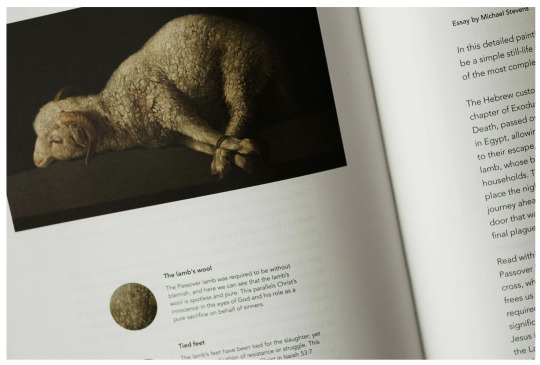
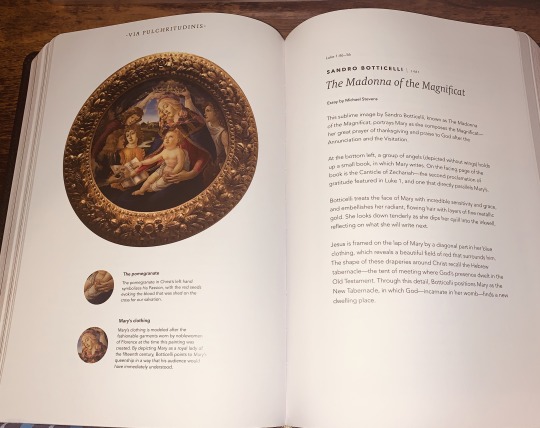
THE DETAILS
Translation: New Revised Standard Version: Catholic Edition
Pages: 591
Church Father Commentaries
Recent Scholars
Bishop Barron Commentaries
Single Column Scripture
Greek Word Studies
Via Pulchritudinis Art and Commentary
Book introductions
Superior quality Artic Paper with a matte-coated finish
Smyth-Sewn Binding
Angelico 9pt Font, (a custom font drawn especially for this Bible). The font is named after Blessed Fra Angelico, a Dominican friar, and Early Renaissance fresco painter.

COVERS:

Leather - $59.95 - Top grain leather produced in Eppertshausen, Germany, along with the gold foil debossed design. The edges of the book block are finished with brilliant gold foil.
Hardcover - $39.95 - Covered in a rich black cloth manufactured by Italian-based Manifattura Del Seveso. It is naturally textured, ruggedly durable, and will resist fading over time. The artwork on the cover and spine is debossed in gold foil.
Paperback - $29.95 - The paperback edition features a scuff-free matte lamination for longevity and the same gold foil-stamped design. This finish will resist fingerprinting and will increase durability.
Order them online now!
FUTURE EDITIONS:
Volume I: The Gospels - June 15, 2020
Volume II: The New Testament - June 2021
Volume III-V: The Old Testament - 2022 and beyond
CHURCH FATHERS AND MODERN SCHOLARS:
St. Augustine
St. John Chrysostom
St. Cyril of Alexandria
St. Irenaeus
St. Gregory the Great
St. Hilary of Poitiers
St. Clement of Alexandria
St. Cyril of Jerusalem
St. Gregory of Nazianzus
St. Gregory of Nyssa
St. Ignatius of Antioch
St. Jerome
St. Justin Martyr
St. Theophylact

Fulton Sheen
G.K. Chesterton
St. Thomas Aquinas
Thomas Merton
St. John Henry Newman
St. Francis de Sales
Hans Urs von Balthasar
René Girard
Flannery O'Connor
Pope St. John Paul II
Joseph Ratzinger (Pope Benedict XVI)
Pope Francis
FINAL VERDICT:
This Bible is an astonishing achievement in the world of Catholic Bibles. You will grow in your faith because of it. I was apprehensive when I first heard about the concept. And I wasn’t alone. The phrase “It sounds like a coffee table bible” parroted time and again. And I thought do I really want a multi-volume bible? Before holding the bible in my hand I thought no, now that I’ve had for a week and a half I scream YES! I do want to disclose that Word on Fire Ministries did send me a copy to review, but was only asked to give an honest review. If the Bible was as disappointing as I thought it would be I would have told you. But I have nothing but glowing praise for the Word on Fire Bible. Great work to the folks at Word on Fire Ministry, Bishop Robert Barron, and Brandon Vogt!

Order The Word on Fire Bible: The Gospels
0 notes
Text
Temples and monasteries of Montenegro - 20 main shrines
New Post has been published on https://tripsterguru.com/temples-and-monasteries-of-montenegro-20-main-shrines/
Temples and monasteries of Montenegro - 20 main shrines

Crystal clear Adriatic Sea, mountain landscape, picturesque valleys, comfortable climate make holidays in Montenegro popular for people of any age. There are no communication problems (minimal language barrier), the infrastructure of the resorts is well organized (relaxation is possible at any time of the year), and a huge number of architectural sights of the country are available for viewing. Among them, in the first place are the famous temples and monasteries of Montenegro, hidden in the thickets of luxurious greenery of rare plants, shrouded in an atmosphere of ancient legends, secrets of Montenegro.
Ostrog Monastery

An endless stream of tourists, pilgrims go to the main attractions of Montenegro. The cloister of the miracle worker Vasily Ostrozhsky is hidden in a rock at an altitude of 900 m above sea level (his relics are the greatest shrine in the world of the Orthodox Church). It has long been a haven for people who believe in help, the fulfillment of the most secret desires of the miraculous power of the Holy.
In a place filled with prayers of a special energy (next to the holy source, miraculous relics), they find help in solving problems, troubles. A sacred place appeared in the middle of the XVII century. The prison consists of two parts: the upper (older) and lower parts, created in the XIX century. In the lower zone is the church of the Holy Trinity with the relics of a 12 year old boy – the martyr Stanko.
The parts are divided by a steep path, about 5 km long, and you can overcome the distance (going uphill) along a special path in 30 minutes. Before the appearance of Vasily Ostrozhsky, hermit monks lived here in a cave hidden from the eyes of people. Gradually, two churches appeared in the sacred place: Holy Cross Exaltation, Vvedensky (Introduction of the Blessed Virgin Mary). In the last place, the Great Miracle Worker, who died in 1671, prayed. His relics (in the role of the main shrine of Ostrog) are stored in a small cave of the Vvedensky church.
Cetinje Monastery

The architectural, historical ensemble of Montenegro is the political, cultural center of the country. Here, on the site of the Zeta (the ancient South Slavic princedom that existed on the site of modern Montenegro), a monastery was built in 1484, which existed until the Turks destroyed it in 1692. The new building was destroyed several times, restored and was the residence of the Metropolitan of Montenegro in its ancient capital – the city of Cetinje, located at the foot of Mount Eagle Cross.
In the Middle Ages, buildings served as a powerful fortress. She was surrounded by a moat with water and stakes, fortified by loopholes. Now you can see part of the brick walls of the fortress. On the historical territory are the Palace-Museum of King Nikola, the Church of the Nativity of the Blessed Virgin Mary.
Here are the remains of the king and his wife Milena, gifts from the emperors of Russia, a valuable collection of prints from the 13-19 centuries. The first printing house of Montenegro worked here. The first high school of the country opened in 1880 within the walls of the building. The famous works of the “Oktoih Pyatoglasnik”, “Psalter”, “Prayer Book”, “Four Gospels” are among the protected shrines. Keeps one of the richest collections of shrines of the Orthodox Church.
Moraca Monastery

One of the main Orthodox monuments of the Middle Ages in the Balkans is an architectural complex consisting of the building of the Cathedral of the Assumption of Our Lady, a small church in honor of St. Nicholas and living quarters for monks. It is located along the right bank of the Moraca Canyon in a beautiful mountainous area. All tourist routes try to include in their programs a visit to this unusual place.
The magnificent building with one nave, a cylinder-shaped soda was erected in 1252 from soft tuff covered with plaster. Of the many frescoes (the 13th-century technique of mural painting has no analogues in beauty), created under the direction of Stevan (the son of the Serbian king). His grave is on a local graveyard.
Now 11 scenes related to the life of the prophet Elijah have been preserved from the interior. The main work on the restoration of the destroyed architectural treasures was carried out in the XVIII century by the artists of Montenegro. The exact time of the construction of the small church of St. Nicholas is not precisely determined: the monks consider it to be a more ancient structure than the cathedral. Of interest is the interior decoration made by ancient murals from frescoes.
Piva Monastery
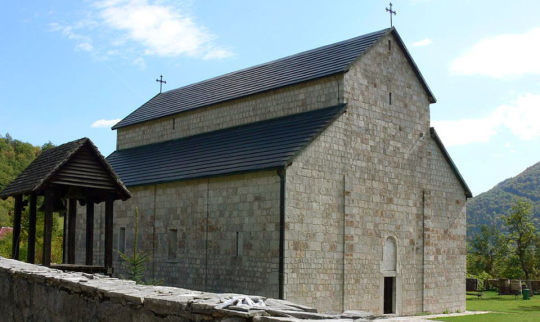
Among the 1600 church sights of the country there are large, small, included in tourist routes, almost forgotten. You are invited to see them on your own or with local excursions. Such a building, called the symbol of invincibility of the inhabitants of the country, is located near Pluzine in the northern part of Montenegro. Among the pine forests near the “Pivsky Oka” in the XVI century there appeared an ordinary house with narrow loopholes that did not attract the attention of the Turks.
Later (after the construction of the hydroelectric power station on the Piva River) the building was moved 2 km higher. In its former place, a guest house (konak), a bakery, a cemetery have been preserved. Here they helped the rebels, sheltered the rebels, held negotiations with representatives of the Christian world. The building is built of stones of gray, pink shades. It has large dimensions: height 13m, length 23, width 15m. The appearance of the building did not cause enemies to rob him.
Inside, there are many old frescoes, a gold-plated iconostasis with a huge cross. A large number of manuscripts, paintings, books, and jewelry are also stored here. One monk lives here permanently. He keeps order, manages the bells, which are not on the roof of the main building, but under the roof of a separate annex. Come to the center of the spiritual life of Herzegovina (now the existing monastery is owned by the Serbian diocese) is proposed by boat on Lake Piva.
Church of the Resurrection of Christ in Podgorica
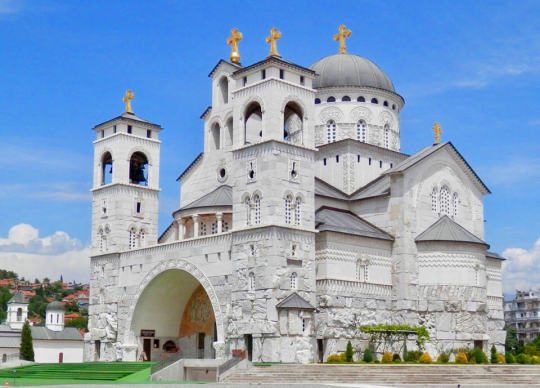
For a long time in the country there was no main church of the Orthodox Church. Since 1993, the first stone was laid in the future huge building, striking in size, splendor of decoration, design. The construction began in the presence of Patriarch Alexy II. The author of the project was architect Pedja Ristic. The building belongs to the Neo-Byzantine style. It included many new architectural elements. The height of the two levels of the cathedral is 41.5 m, the belfry is made of 17 bells (2 brought from Voronezh), 7 crosses sparkling with gilding.
The monumental view of the building is formed by huge blocks of stone, decorated with antique. The interior is characterized by an abundance of images made of small pieces of granite, marble. Mosaic “Noah’s Ark”, a fresco above the entrance measuring 53.5 m 2. In one of the largest temples in Europe at the same time accommodates up to 5 thousand believers.
Daibabe Monastery in Podgorica

At a distance of 4 km from the capital of Montenegro is an amazing place hidden in rocky caves. You can find it by a small building dedicated to the Assumption of the Blessed Virgin Mary with belfries on the sides. The main premises are underground in caves located in the shape of a cross. Local legends say that as early as the III century, the first Christians were hiding in catacombs with their own source of water. The monastery appeared in 1897 and its first rector was the miracle worker Simeon of Daibab (his relics are stored here).
The first liturgy was performed in the cave church in January 1897. The dimensions of the cave used are 20 m in length and about 3 m in width. Chapels are hollowed out on the side walls; an altar is located in the center. The ceiling, the walls were painted by Simeon, his followers. The surviving murals are of great value. In an atmosphere of silence, peace, numerous pilgrims receive relief, hope for a favorable solution to their problems.
Cathedral of St. Tryphon in Kotor
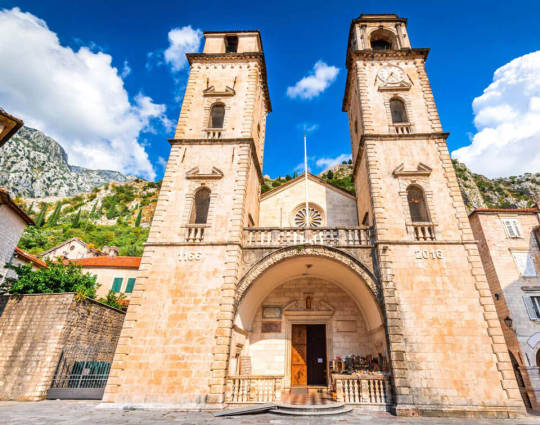
The ancient building is depicted on the coat of arms of the city of Kotor. Saint Tryphon, repeating the path of Jesus Christ, is considered the patron saint of the city. The cathedral in his honor was laid in 1166. Previously, this place was a church, built in 809 by the noble townsman Andrii Saracenis. It was he who bought the relics of St. Tryphon au merchants of Venice.
The devastating earthquake of 1667 required the rebuilding of the bell tower of the cathedral. They are made in the form of high towers (up to 35 m high) made of special stone brought from the island of Korcula. Above the entrance is a window in the shape of the famous “outlet”. The ancient frescoes of the interior are poorly preserved. But even now, under centuries-old layers of stucco, lime on the apse, nave arches fragments of Byzantine-style paintings are revealed.
The exact time, the author of their writing remains the secret of the cathedral. The origin of the rare wooden crucifix in the church is also unknown. The relics of St. Tryphon are considered the main shrine of the Cathedral. In the sarcophagus, standing to the right of the entrance, lies the body of Andria Saracenis. The Cathedral, as a preserved example of the style of Romanesque architecture, is a World Heritage Site.
Church of St. Luke in Kotor
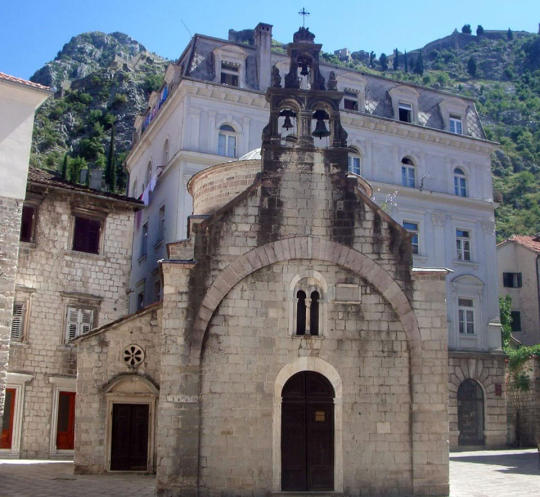
A modest, not conspicuous temple, standing in the historical part of Kotor, is in fact a famous landmark and the oldest church in Montenegro. It was built in 1195 at the expense of the rich feudal lord Kazafragi (a memorial inscription testifies to this). In the current church there are two altars: Catholic and Orthodox), which is rarely found in temples of the world. The two branches of the Christian religion lived here peacefully, in harmony. The main shrines of the cathedral are particles of the relics of St. Luke, the martyrs of Orestes, Mardarius, Auxentius.
Among the interior, fragments of ancient frescoes by Italian, Cretan masters of the 17th and 18th centuries have been preserved. In a small chapel owned by the church, there is a unique iconostasis depicting Christ in the image of the King. The temple opens on holidays, before the planned excursions, weddings, baptisms. An interesting fact is the burial of local residents inside the building. Its entire floor consists of grave gravestones. During the great earthquake of 1979, this church was the only building that was not damaged.
Church of St. Nicholas in Kotor

On Grets Square in the old center of Kotor rises a relatively young Cathedral building, erected in honor of the patron saint of travelers, sailors St. Nicholas. Historically, the existence of a Dominican monastery in this place, turned into a soldier’s barracks for Napoleon’s army, is historically confirmed. After the destruction of the church was built here, life, which broke off the fire of 1896. A new temple was erected on its foundation in 1909.
The building is in line with the pseudo – Byzantine architectural style. At the entrance are two tall belfries. Among the interior decoration stands the iconostasis of three meters high, created in 1908 by Czech artist Ziegler. The treasury of a beautiful building contains many valuable documents, icons, art objects, clothes. The most interesting are the Three-Handed icon, the book “The Sacrifice of Abraham of 1899”, the image of Nicholas the Wonderworker in the form of a mosaic at the entrance. In the courtyard you can use a source of healing water. Services are held daily.
Church on the Island of the Virgin

The history of the creation of the ancient church on the reef, which turned into an island in the original construction way, annually attracts many tourists to the city of Perast. Virgin Mary, living on a reef, protects the local sailors. As a token of gratitude, the locals regularly spend here a feast of fashinada. On decorated boats, they swim around the island three times and throw stones into the water, strengthening the shore.
In such a strange construction way, for almost two centuries, stones were collected on the sunken ships, reefs, a stable platform was formed. It grew an ancient landmark of the country church. The ground floor of the building is decorated with icons, paintings of artists of the 17th century, an organ sounds, whose age is 300 years. The altar is made of four types of valuable snow-white marble and is decorated with the image of the face of the Holy Virgin. It illuminates the interior of the chandelier made of real Murano glass, made almost 3 centuries ago. The archaeological museum is invited to see old exhibits: Roman crosses, a fountain, silver roots.
Drimsim is the first universal sim card for travelers. Internet abroad starts at $ 1 per megabyte, and calls start at $ 3 per minute. Works in 197 countries!
Lifting mechanisms, lights, bells and other elements belonging to ships of different countries at many times. On the second floor are amazing ancient amphoras, jugs, mysterious captain’s chests. A collection of paintings depicting ships, the olive stele of Diva, adorning the bow of a ship in the Middle Ages. Among them is a unique icon of the Holy Virgin, embroidered by a woman from Perast, who had been waiting for 25 years for the return of her sailor husband. Thousands of plates (gold, silver, bronze) are mounted in the walls of the building. They were presented by sailors (the custom still exists) in gratitude to the Virgin for a successful voyage.
Cathedral Church in Bar

A magnificent building was built on the site of the construction of the XVI century in 1863. The last reconstruction was carried out in 2016. The cathedral was consecrated in the name of the first ruler of Montenegro, Jovan Vladimir, who accepted the death of a martyr on the cross. The snow-white architectural creation is decorated with three golden, sparkling domes. They are trophies taken during the Austro-Hungarian occupation in 1918. All bells, guns, cores were remelted and new ones were made. For the past few decades, the cathedral has been the main Orthodox church in the city.
For the manufacture of walls, a beautiful-looking solid stone (red limestone) was used. On the facade there is a window in the form of a “rose outlet”. Inside the cathedral, frescoes with images of Saints have been preserved. The cathedral church is called the largest religious building in Montenegro. Its height is 41 m, an area of 1200 m2. Services are held daily. In a special room of the amphitheater, events are held for cultural and spiritual development of the population.
Gradiste Monastery

In 1116, the construction of Hradiste began on the site of ancient buildings (Grajevine) and the old Greco-Roman cemetery. It became a monument of fresco painting of the Middle Ages in Montenegro. The surviving ensemble includes a cell building, the ruins of a protective wall, a cemetery, and the structures of three churches.
Among them:
Saint Sava. One-nave building of alternating rows of white, red stone and a belfry with three bells. The iconostasis was painted by Nicholas Aspiotis in 1864.
St. Nicholas. Built in the XII century, painted by a fresco master from Budimlya. Among his creations is the fresco “Mammal” (patroness of young mothers). In antiquity, mother’s gifts that did not have breast milk were left next to her. A luxurious carved iconostasis appeared here in 1796.
Assumption of the Blessed Virgin Mary. The small building is located on the upper platform next to the cemetery. The frescoes depict saints from the Nemanich family.
The buildings suffered greatly from destruction during the invasion of the Tatars, the French, during the war of 1941, from a severe earthquake.
Podmaine Monastery in Budva

Historical facts indicate the emergence of a Christian structure at the foot of Mount Ostrog or in a place called Maina, around the time of the reign of the Nemanichi dynasty. For a long period of time here was the residence of the country’s metropolitans. Within its walls, Negosh wrote a literary work, “The Crown of the Mountains,” which became the literary monument of Montenegro. The buildings were given a new life by the modern restoration and opening of the complex in 1995. The complex includes two churches dedicated to the Assumption of the Blessed Virgin Mary.
The large building was renovated in 2000. The icon painter again portrayed the scenes of the Last Judgment, placing among the sinners the image of the communist leader Broz Tito of Yugoslavia. The small church (4 m long and 2.5 m wide) is a catacomb of the first Christians and is located under cells. The building was built in the XII century. A stone water tank is installed in the center. She is famous for amazing stone carving. There is an inscription in the room, indicating that the last restoration took place in 1630.
Dulevo Monastery
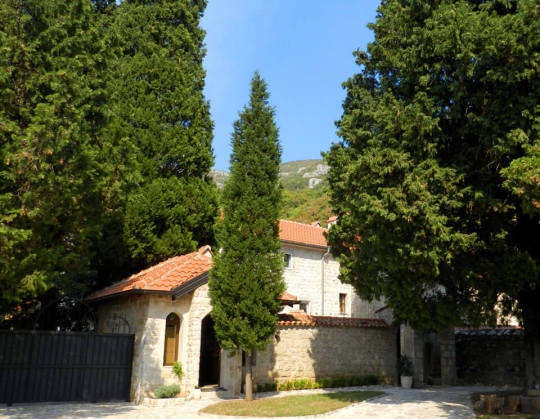
There is a written mention of the structure that appeared in honor of the soldiers of King Dushan in the middle of the XVI century. The novices of the Decana parish came here after a haircut. The building was often destroyed by wars, natural disasters. Now it is fully restored. On the walls of the south and north sides are visible traces of former buildings, a cell building with narrow windows in the form of loopholes, a belfry with a bell. Inside the old building, fragments of two layers of ancient painting, the original frescoes, have been preserved.
They depict scenes from the lives of saints and are a matter of pride. The vault of the room is decorated with compositions covering important gospel events: the Present, Christmas, and the Crucifixion. On it are six medallions depicting Christ, Our Lady of Oranta, and saints. Two cells are located in the upper part of the building (Saint Sava worked in them before traveling to the Holy Mountain).
On the territory there is a source (Savvina Voda), which helps pilgrims treat diseases of the stomach. According to legend, the soldiers of King Dushan were healed of typhoid fever by this water. It is also proposed to see an old oak tree under which Saint Sava sat. The complex is located on a plateau above St. Stephen.
Praskvitsa Monastery
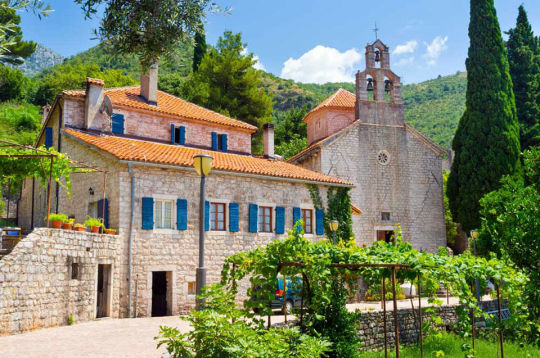
High in the mountains, near the villages of St. Stephen and Pržno, not far from a stream that smells of peaches (where the name of the building came from), an ancient monastic monastery lurks. The religious shrine of Montenegro appeared in 1059. After severe destruction, a new stage in her life began in 1844. The new church of St. Nicholas (the original construction was carried out in 1413), together with the Holy Trinity Church and monastery cells, are included in the architectural ensemble, which is a landmark of the country.
Along with the tour, you can sit at a stone table where the council of elders made crucial decisions of the Middle Ages. Visit the museum with a treasury. It contains a valuable collection of icons, ancient artworks, ancient weapons. Manuscript books (among them the Gospel of the 16th century), documents of the Pashtrovich era, an old monastery seal, the golden cross of Dushan. In the cells there is a valuable library with a total number of books over 5,000 copies.
Rustovo Monastery
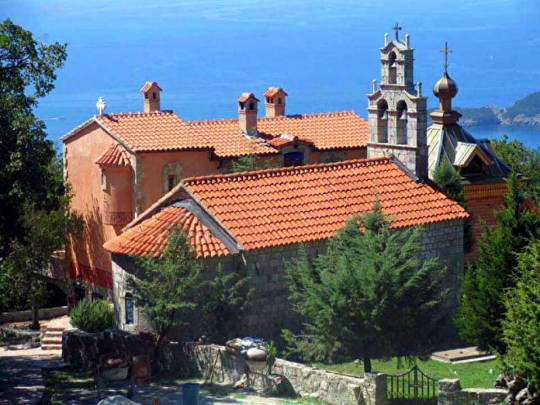
In the current monastery for nuns live 8 sisters. They serve the buildings included in the monastery ensemble. Today it includes the construction of three temples. In 2003, a monastery was founded on the site of the ancient church of the Assumption of the Blessed Virgin Mary (built in the XIV century, destroyed by fires, an earthquake). His consecration took place on the Epiphany Eve. You can still consider the preserved foundation of the ancient structure.
During the construction process, the remains of the pastoral martyrs of the XIV century were found. Archbishop Amphilochius laid the foundation in 20005 for a small cathedral dedicated to members of the Romanov family who were martyred. The remains of the XIV century sufferers were first placed under the altar of a large church, and then buried in the foundation of the Romanov temple.
The third temple (paraclis) is located in the cell building. It is dedicated to the famous saint of the VI century, who founded a large number of temples. Located next to Chelobrodo Hill. It offers a panorama of the most beautiful part of the Adriatic Sea of Montenegro.
Church of the Archangel Michael in Herceg Novi
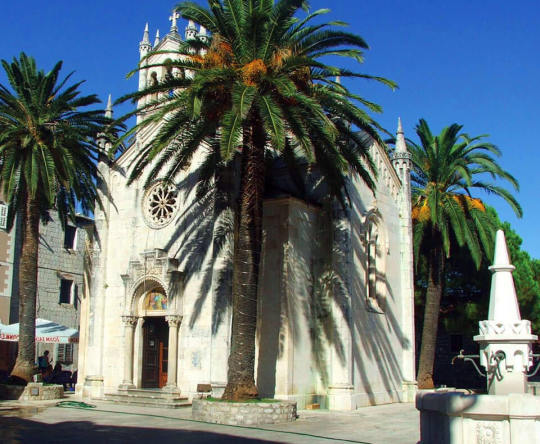
The Orthodox Church, whose age is just over 100 years old, is considered the pearl of the Montenegro region. It stands in the center of the old quarter, on the Stefan Vukmcha square in Herceg Novi. The unusual architectural style is associated with the participation of several architects in its construction. Each of them expressed his preference for the Romanesque, Byzantine, Gothic, Baroque, Islamic architectural heritage. All elements blend in harmoniously and form a unique appearance of the structure.
The interior is striking in its exquisite beauty. The altar and iconostasis were made by master Bilinich from beautiful, rare marble. Many icons are considered rare, unique. They are written by Czech artist Ziegler. The local library holds a large number of church books, including from Russia. The building is surrounded by majestic palm trees. On the beautiful square there are many cozy cafes, places for relaxation, viewing the temple.
Church of the Savior in Herceg Novi

Behind a high stone fence on the main street (Negosheva) is an old temple complex consisting of the churches of the Savior and St. George. The first was built in 1713 from stone blocks brought from the island of Croatia. It received its final appearance in 1864 as a result of a complete restructuring, starting with the foundation. In the middle of the next century, an interesting iconostasis appeared in the building, a belfry with three bells.
Among the many decorations of the interior are several Russian icons. The Church of St. George was built at the end of the 17th century. This place used to be a Turkish mosque. The main shrine is a round icon depicting Saints Peter and Paul. The archives store old books, icons, church dishes made of silver. Behind the fence is an old cemetery, a two-story building of the residence of the bishops of 1700, a school where the future famous poet and priest of Montenegro Negosh studied.
Savina Monastery

The current complex (10 monks live in it), surrounded by a garden with many exotic plants, is the center of Orthodoxy among the settlements along the Boka Kotorska Bay. It is named after the first archbishop of Serbia, St. Sava. The complex includes three buildings: Malaya Uspenskaya, Bolshaya Uspenskaya and St. Sava Church (it is located next to the upper cemetery). The Small Cathedral (10 m long and about 6 m wide) was built in 1039.
The main preserved value is the ancient frescoes made in the Byzantine, Gothic styles. At the end of the 18th century, under the leadership of the Venetian architect Nikola Foretic, the Great Temple was built in the style of luxurious baroque. The iconostasis of the 18th century, consisting of separate zones created in the traditions of the Orthodox style of the east, has been preserved.
Sacred relics are considered to be a crystal cross belonging to Savva and decorated with rubies, the relics of Tsarina Helena, George the Victorious, the shroud of 1642. Icon collection, library containing over 5,000 rare manuscripts, handwritten gospel. The church of St. Sava was built by him in the 1230s. Now it is used as the parish church of the monastery.
Banya Monastery in Risan

The existing convent, founded in the 15th century, is located on the shore of the Gulf of Risan. In ancient times, there were Roman baths, which gave the name to the new building. In the XVII century, a temple was erected on the foundation of an ancient medieval fortress in honor of St. George the Victorious. Particles of the relics of the great martyr are the main shrine. The existing look was created during the restoration in 1729, carried out at the expense of wealthy sailors of the region.
Now here you can see old icons, clothes used during religious rituals. It is skillfully embroidered with silver, gold threads, decorated with gems. Many faces of saints are made using the techniques of ancient embroidery. The library archive contains a large amount of church literature. It is allowed to visit the interior with a guided tour, groups of pilgrims when performing the prescribed form of clothing and observing all the rules.
#Banya Monastery in Risan#Cathedral Church in Bar#Cathedral of St. Tryphon in Kotor#Cetinje Monastery#Church of St. Luke in Kotor#Church of St. Nicholas in Kotor#Church of the Archangel Michael in Herceg Novi#Church of the Resurrection of Christ in Podgorica#Church of the Savior in Herceg Novi#Church on the Island of the Virgin#Daibabe Monastery in Podgorica#Dulevo Monastery#Gradiste Monastery#Moraca Monastery#Ostrog Monastery#Piva Monastery#Podmaine Monastery in Budva#Praskvitsa Monastery#Rustovo Monastery#Savina Monastery
0 notes
Text
Mary (and us): ‘Container of the Uncontainable’

The Byzantine origin of this image is called Χώρα του Αχωρήτου (Chora tou Achoretou – Container of the Uncontainable). Christmas celebrates that the Uncontainable One is contained in Mary! And the point of this Incarnation is that we too, each one of us, become a Container of the Uncontainable.
Our Lady of Montserrat is a Marian title associated with a venerated statue of the Madonna and Child venerated at the Santa Maria de Montserrat monastery on the Montserrat Mountain in Catalonia, Spain. The wood sculpture is probably from the late 12th century.
https://en.wikipedia.org/wiki/Virgin_of_Montserrat
The art historical designation for this type of pose is called "Throne of Wisdom". The body is thin, the face elongated. She holds an orb of the earth in her right hand. The Child's hand is raised in a formalized and traditional Eastern blessing. This type of madonna image is based on the Byzantine prototype of the Chora tou Achoretou ("Container of the Uncontainable"), an epithet mentioned in the Acathist Hymn and present in the Greek East by the early 11th century, The Sedes sapientiae icon also appeared in illuminated manuscripts and Romanesque frescoes and mosaics, and was represented on seals.
The identification of Mary as the ‘Throne of Wisdom’ came through typological interpretation of the passage in the Books of Kings, that describes the throne of Solomon (I Kings 10: 18–20, repeated at II Chronicles 9: 17–19).
https://en.wikipedia.org/wiki/Seat_of_Wisdom
+++ T
Further reflections by Bosco Peters, an Anglican priest in New Zealand, and published online at his blog at
http://liturgy.co.nz/container-of-the-uncontainable
She is in the style of the ‘Throne of Wisdom’. Mary becomes, as it were, the throne for Christ. She is the Seat of Wisdom. The Byzantine origin of this image is called Χώρα του Αχωρήτου (Chora tou Achoretou – Container of the Uncontainable). This, I find, such an attractive metaphor. God is the Uncontainable One – certainly not containable in words, by metaphors, or images. Here is the apophatic tradition (God is not like this; God is not like that…) in one word – uncontainable. And yet, Christmas celebrates that the Uncontainable One is contained in Mary! And the point of this Incarnation is that we too, each one of us, become a Container of the Uncontainable.
+++
Further information below is from an essay by Berfu Durantas published online at
https://www.khanacademy.org/humanities/medieval-world/latin-western-europe/romanesque1/a/throne-of-wisdom
A good example of a “Throne of Wisdom” sculpture which still retains some of its original color is found at the Cloisters Museum, a branch of the Metropolitan Museum of Art in New York. The sculpture is made from several pieces of walnut doweled together. Originally, the Virgin wore a red robe covered by a dark blue mantle which was decorated with tin leaf to simulate gold. Christ’s tunic was originally a dark green with red lining, covered by a red overgarment known as a himation. This too was originally decorated with tin leaf.
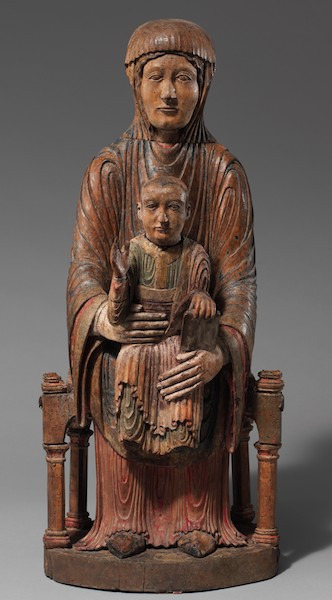
The sculpture puts into visual form the typological tradition of comparing Mary to the Throne of Solomon (typology refers to the idea that events and individuals in the Old Testament prefigured those in the New Testament). King Solomon’s famous throne is described in the Book of Kings of the Old Testament as a throne of ivory covered in gold. Christ, like his ancestor King Solomon, embodies wisdom and justice. Thus, Mary is a Sedes Sapientiae or Throne of Wisdom—the Mother of God, enthroned herself, who serves as a throne for the son of God turned into human flesh. The Christ Child on her lap represents divine wisdom incarnate, whose wisdom is communicated through his adult features, making him look like a miniature man. The open bible he holds is also a representation of the divine wisdom he embodies.
+++
Top image by Enrique López-Tamayo Biosca – https://www.flickr.com/photos/eltb/3227926254/, CC BY 2.0, Link
+++
Since I’m most interested in contemporary art, here are some more modern depictions of Mary as the ‘Throne/Seat of Wisdom.’ To qualify, a picture must show a young Jesus on the lap of Mary with his hands shown.
Mary, Seat of Wisdom, Artwork by Br. Mickey McGrath, OSFS
https://fineartamerica.com/featured/mary-seat-of-wisdom-mmwis-br-mickey-mcgrath-osfs.html

+++
From India?

+++
From China:

+++
"Madonna and Child" ~ Margaret Keane, 1962

+++
Artist unknown

+++
Artist unknown.

+++
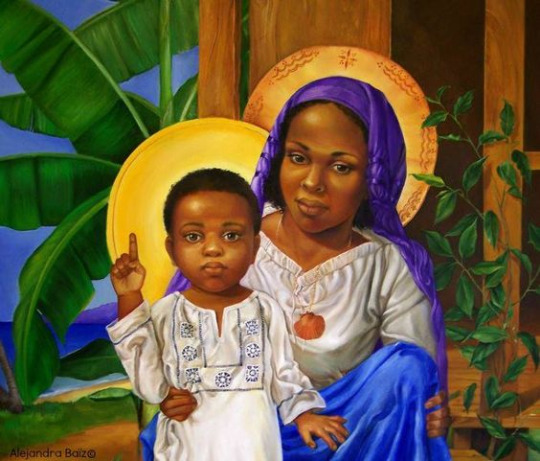
+++
Madona by Ismael Saincilus, Haiti
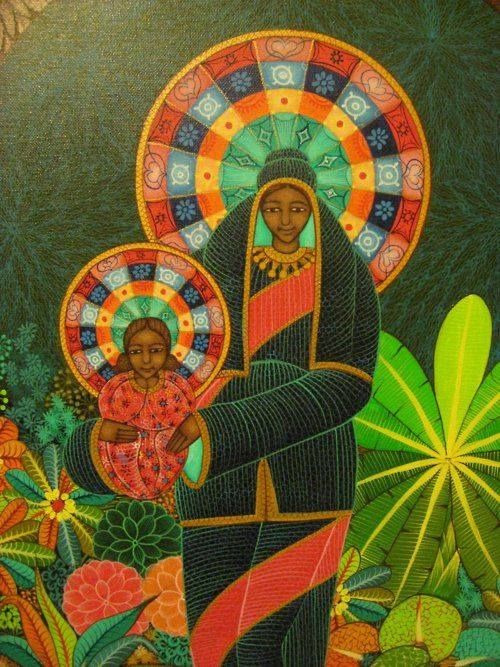
+++
‘Our Lady of the Sign’ by EvitaWorks
https://www.etsy.com/listing/125480131/our-lady-of-the-sign-mother-son-art

+++
By Claire Berlein (South Africa)
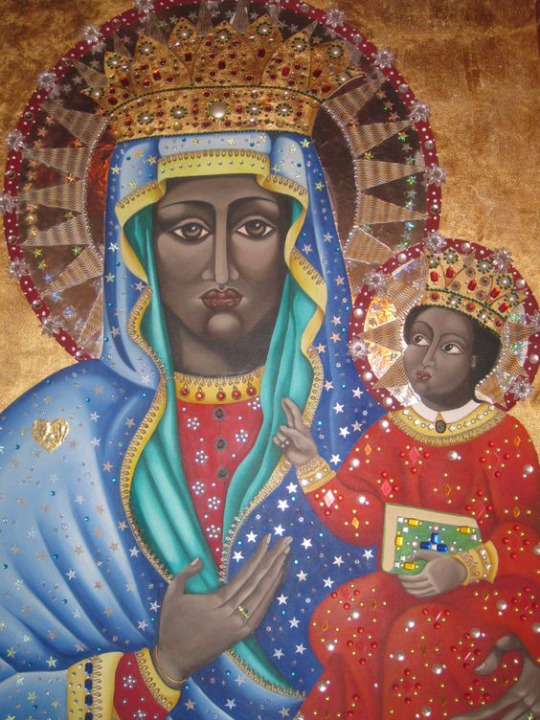
+++
Artist unknown.

+++
Artist unknown
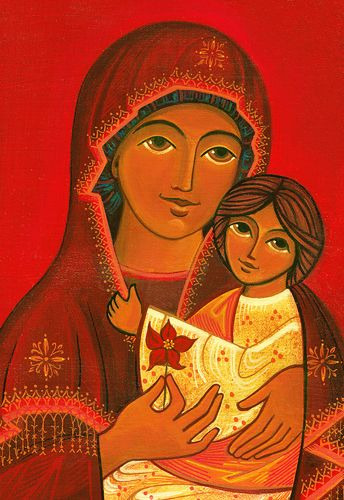
+++
Also see my previous post:
45 'Madonna & Child' Contemporary Paintings in Global Art
http://globalworship.tumblr.com/post/106578990530/45-madonna-child-contemporary-paintings-in
1 note
·
View note
Text
The Sixth Sunday After Epiphany
Hebrew Scripture Lesson from the Latter Prophets: Jeremiah 17:5-10
Thus says the Lord:
Cursed are those who trust in mere mortals
and make mere flesh their strength,
whose hearts turn away from the Lord.
They shall be like a shrub in the desert,
and shall not see when relief comes.
They shall live in the parched places of the wilderness,
in an uninhabited salt land.
Blessed are those who trust in the Lord,
whose trust is the Lord.
They shall be like a tree planted by water,
sending out its roots by the stream.
It shall not fear when heat comes,
and its leaves shall stay green;
in the year of drought it is not anxious,
and it does not cease to bear fruit.
The heart is devious above all else;
it is perverse—
who can understand it?
I the Lord test the mind
and search the heart,
to give to all according to their ways,
according to the fruit of their doings.
Psalm 1
Happy are those
who do not follow the advice of the wicked,
or take the path that sinners tread,
or sit in the seat of scoffers;
but their delight is in the law of the Lord,
and on his law they meditate day and night.
They are like trees
planted by streams of water,
which yield their fruit in its season,
and their leaves do not wither.
In all that they do, they prosper.
The wicked are not so,
but are like chaff that the wind drives away.
Therefore the wicked will not stand in the judgment,
nor sinners in the congregation of the righteous;
for the Lord watches over the way of the righteous,
but the way of the wicked will perish.
New Testament Epistle Lesson: 1 Corinthians 15:12-20
Now if Christ is proclaimed as raised from the dead, how can some of you say there is no resurrection of the dead? If there is no resurrection of the dead, then Christ has not been raised; and if Christ has not been raised, then our proclamation has been in vain and your faith has been in vain. We are even found to be misrepresenting God, because we testified of God that he raised Christ—whom he did not raise if it is true that the dead are not raised. For if the dead are not raised, then Christ has not been raised. If Christ has not been raised, your faith is futile and you are still in your sins. Then those also who have died in Christ have perished. If for this life only we have hoped in Christ, we are of all people most to be pitied.
But in fact Christ has been raised from the dead, the first fruits of those who have died.
New Testament Gospel Lesson: Luke 6:17-26
There is a parallel passage at Matthew 5:1-12.
Jesus came down with them and stood on a level place, with a great crowd of his disciples and a great multitude of people from all Judea, Jerusalem, and the coast of Tyre and Sidon. They had come to hear him and to be healed of their diseases; and those who were troubled with unclean spirits were cured. And all in the crowd were trying to touch him, for power came out from him and healed all of them.
Then he looked up at his disciples and said:
“Blessed are you who are poor,
for yours is the kingdom of God.
“Blessed are you who are hungry now,
for you will be filled.
“Blessed are you who weep now,
for you will laugh.
“Blessed are you when people hate you, and when they exclude you, revile you, and defame you on account of the Son of Man. Rejoice in that day and leap for joy, for surely your reward is great in heaven; for that is what their ancestors did to the prophets.
“But woe to you who are rich,
for you have received your consolation.
“Woe to you who are full now,
for you will be hungry.
“Woe to you who are laughing now,
for you will mourn and weep.
“Woe to you when all speak well of you, for that is what their ancestors did to the false prophets.”
Year C Epiphany 6 Sunday
Selections from Revised Common Lectionary Daily Readings copyright © 1995 by the Consultation on Common Texts.
Unless otherwise indicated, Bible text is from Holy Bible New Revised Standard Version (NRSV) copyright © 1989 by the Division of Christian Education of the National Council of Churches of Christ in the United States of America. Used by permission. All right reserved.
Parallel passages are as indicated in the Modern English Version (MEV) , copyright © 2014 by Military Bible Association. Used by permission. All rights reserved. When text is taken from the MEV, the passage ends with (MEV) and the foregoing copyright notice applies.
Image credit: The Sermon on the Mount by Cosimo Rosselli via Art and the Bible. This is a fresco on the northern wall of the Sistine chapel in the Vatican. This is a public domain image.
0 notes
Text
JONAH IN ART: CHANGING PERSPECTIVES
Academy Journal Beta.1, 7-13 (2017)
Printed in the United States
CC BY-NC-ND license
By Dr. Ann Plogsterth
Over time, Jonah has inspired varied religious and artistic interpretations, focusing on different aspects of the complex tale. It is even found in the Quran (37:139) and in Near Eastern art (fig. 1). Only the first part of Jonah’s story is covered in our oratorio, and it focuses on the theme of the prophet’s disobedience.
The first Christians were, of course, Jews, well versed in the Hebrew Scriptures. They knew the book of Jonah, unique among the prophetic books in that it is entirely narrative and contains no real oracle. They also knew the tradition that would later become the New Testament. Both Matthew (12:40–41; 16:4) and Luke (11:29–32) speak of the sign of Jonah, whose three days and three nights in the belly of the whale1 were seen as prefiguring Jesus’s three days in the abode of the dead and his ultimate Resurrection; this connection is explicitly spelled out in the first Matthean passage.
So it should be no surprise that Early Christian sarcophagi and catacomb frescoes are especially fond of Jonah’s story, perhaps adding allusions to baptism, the gateway to resurrection—allusions which would have been apparent only to initiates. Jonah often emerges from the fish naked and bald, with a baby face (as if newly reborn) and in an orant pose, and the scene of him resting under the gourd tree (an incident not included in the oratorio) reflects the blessed soul of the baptized and resurrected Christian.2 In some fourth-century sarcophagi (fig. 2), Jonah under the tree is juxtaposed with a scene of Peter baptizing his jailers: first, baptism in this life, then paradise in the next.
In the sixth to eleventh centuries, Byzantine manuscripts expanded the narrative cycle to include further events: Jonah’s calling, his embarkation, and his preaching at Nineveh (fig. 3). These exquisite works influenced Jonah’s depiction in icons through subsequent centuries.
In the Middle Ages, the connection with Jesus’s Resurrection remains (figs. 4, 5), as do the narrative scenes, but, apart from these, Jonah also appears among group depictions of the prophets. In psalters and books of hours, Jonah and his whale were sometimes placed with Psalm 68/69,3 with its references to rising waters. An Ordo for commending a soul at the time of death prayed, “Sicut liberasti Jonam de ventre ceti, eicias me de morte ad vitam” (As you freed Jonah from the whale’s belly, may you cast me from death into life).4 One curious use of the Jonah theme is on South Italian ambos and preacher’s chairs, where it might be seen as a warning to reluctant preachers: Jonah’s disinclination to address the Ninevites did not work out well for him.
An important new medieval use of the Jonah theme is found in manuscripts and printed books like the Biblia pauperum and Speculum humanae salvationis. Both were collections of New Testament events joined to their Hebrew prototypes, with suitable quotations from the prophets, often in the vernacular (figs. 6, 7). For instance, Jesus’s burial is paired with Jonah swallowed by the whale and Joseph thrown into the cistern; the Resurrection parallels are Sampson destroying the gates of Gaza (as Christ burst the gates of death) and Jonah emerging from the whale.
In the Renaissance and Baroque, both narrative cycles and allegorical allusions disappear, and we find more or less realistic depictions of a large fish and a man (fig. 8). Although Jonah is usually shown elderly, befitting a prophet, Lorenzetto portrayed an Apollo-like young Jonah (fig. 9); writing of this work, Vasari noted its allusion to the resurrection of the dead, a symbolism still remembered then. Michelangelo’s massive Jonah in the Sistine Chapel makes, by its placement, a connection between Jonah and the Christ of the Last Judgment (fig. 10), again perhaps reiterating the Resurrection theme.
By the time of our oratorio, the Biblia pauperum was hardly current reading and the scholastic mindset that searched for typologies was no longer prevalent, although probably remaining as a subconscious influence.5 Giona ignores the traditional connections with resurrection and baptism, focusing entirely on the motif of Jonah’s disobedience and subsequent obedience, a theme much harder to depict visually.
By the nineteenth century, all connections beyond the details of the actual story seem to have been lost, and we are left with a simple adventure story. Perhaps the most significant artist to depict Jonah then was James Tissot in his massive series of watercolors on the Bible (fig. 11). Eventually, the theme is taken over by Sunday-school illustrations (fig. 12), which can come to rival very bad cartoons (fig. 13). Sometimes the depiction reflects a hyper-literal interpretation of Scripture (figs. 14, 15). In Israel Jonah has generally received more serious artistic treatment (figs. 16–18), though, even there, one finds exceptions (fig. 19). Perhaps humanity can no longer deal with miracles or with metaphor; in this modern age we cannot see past the details of whale anatomy to perceive the prophet’s underlying message.
Dr. Ann Plogsterth has a doctorate in art history from Columbia University and a lifelong obsession with religious iconography.
_______________
1. Actually “great fish” in Hebrew, and variously depicted as fish, seahorse, or sea monster.
2. The Vatican’s famous Jonah Sarcophagus pairs the prophet’s story with several scenes suggesting the saving waters of baptism (Noah in his ark receiving the returning dove [cf. 1 Peter 3:20–21], Moses striking water at Massah and Meribah) and the resurrection of the dead (raising of Lazarus).
3. The Hebrew and Greek Bibles number the psalms differently. Jews, Protestants, academics, and modern Catholics use the Hebrew system; Orthodox and traditional Catholics follow the Greek Septuagint.
4. Louis Réau, Iconographie de l’art chrérien, 1955, Vol. 2, Part 1, p. 415.
5. The connection of Jonah to the Resurrection persists in odd places: a gravestone c.2013 in the Ratzeburg cathedral cemetery depicts Jonah and the whale, and a 2014 Good Friday procession in Malta includes Jonah and his maritime companion.
#academy journal#academy of sacred drama#art#art history#jonah#volume beta#number 1#ann plogsterth#religion
0 notes
Text
798G Anon
The Compleat Sheriff: wherein is set forth, his office and authority; with directions, how and in what manner to execute the same, according to the common and statute laws of this kingdom, which are now in force and use: and the judgments and resolutions of the judges in divers late cases in the several courts of Westminster, relating thereunto. Likewise of Under-Sheriffs and their deputies… to which is added, the office and duty of coroners, and many modern adjudged cases relating to the office of a Sheriff to this time, &c.
In the Savoy: printed by John Nutt. 1710 £2900
Octavo 7 ½ X 4 ½ Bound in full contemp. panelled calf, raised bands, gilt dec. spine; lacking label, sl. cracking to head of upper joint. Armorial bookplate of the Marquess of Headfort. v.g. Second Edition with additions. This is one of those books in which the Title says it all..even including the duties of the Coroners!
ESTC T90638, BL, NLW, Oxford & National Trust only in British Isles; Columbia, Harvard & Kansas in North America.
649G Anon ( but probably Roger L’Estrange, 1616-1704)
A compendious history of the most remarkable passages of the last fourteen years: with an account of the plot, as it was carried on both before and after the fire of London, to this present time
London: printed by A. Godbid, and J. Playford, and are sold by S. Neale, at the Three Pigeons in Bedford-Street over against the New-Exchange 1680 £2,400
Octavo , 7 X 4 ½ inches First edition A (-A1) B-O . With frontis. portraits (plate) of Titus Oates, Captain William Bedloe, Stephen Dugdale, and Miles Prance. As well as a large fold out of London Bridge.
This is a wonderful copy expertly rebacked retaining the original sheep boards.
The (Horrid) Popish Plot , a fabrication of the evil and twisted mind of Titus Oates. On 28 September 1678, Oates made 43 allegations against various members of Catholic religious orders — including 541 Jesuits — and numerous Catholic nobles. He accused Sir George Wakeman, Queen Catherine of Braganza’s physician, and Edward Colman, the secretary to Mary of Modena, Duchess of York, of planning to assassinate Charles. Oates was playing on two divergent groups of Zealous biggots.
Wing L1228
682G Charles-Alphonse Dufresnoy 1611-1688 Translated by John Dryden 1631-1700
De arte graphica. The art of painting, by C.A. Du Fresnoy. With remarks. Translated into English, together with an original preface containing a parallel betwixt painting and poetry. As also a short account of the most eminent painters, both ancient and modern, continu’d down to the present times, according to the order of their succession. By another hand.
Heptinstall for W. Rogers, at the Sun against St. Dunstan’s church in Fleetstreet, 1695 £2,200
Quarto 8 1/8 X 6 in [ ]2, (a-h)4, B-Z4, Aa-Yy4, Zz2. Internally, this copy is in very good shape. This copy is the first edition of the text in English translation. Bound in contemporary paneled calf it is a very clean large copy.; the spine’s title label has been replaced. “His progress in his studies was more than usually promising; he soon became well versed in the classics, and at an early period of his life showed a mark genius for poetry” (Bryan’s D-96). He was a working artist who established himself within a circle of peers that inlcuded Poussin, Claude Lorrain, and, close friend, Pierre Mignard who spent several years with him in Italy. Dufresnoy and Mignard were involved in copying Annibale Caracci’s frescoes into the Farnese Palace. However, “Dufresnoy was before all things a critic, and his best known work is not a painting, but a book, “De Arte Graphica”, a manual written in extremely elegant Latin verse…and reprinted for a hundred years as a masterpiece” (CE vol.X, p.289). The academic and creative impact Dufresnoy’s book had was great; his influence reverberated across the artistic community. This is particularly clear within his circle of friends, “this rare amateur wielded a great educational influence over Mignard, and made him acquainted with Venice and its incomparable school, which our classic art had professed to despise” (CE). Lowndes describes the book as “a work of established reputation” (p. 163) and the text itself includes Dufresnoy’s explanation of the art of painting. Examples of some topics covered include “The motions of the hands and head must agree”, “The conduct of the tones of Light and Shadows”, “The reflection of colours”, “Things which are vicious in painting to be avoided”. There is also an interesting account of “the most eminent painters, both ancient and modern” by his personal judgement (includes articles on Vouet, Caravaggio, his hero, Titian, and others).
“Painting and Poetry are two Sisters, which are so like in all things, that they mutually lend to each other both their Name and Office. One is call’d a dumb Poesy, and the other a speaking Picture” (from pg. 3 of “De Arte Graphica”). Dufresnoy and Dryden helped assure this filial association between the two popular arts of painting and poetry. This text laid the groundwork for Jonathan Richardson’s seminal “Essay on the Theory of Painting” published in 1715 – a work that has been hailed as the “starting point for the classical school of art criticism in Britain” and the study of aesthetics. “ (Prince, “Aesthetics: Sources in the Eighteenth Century”).
Wing D-2458 ; H. Macdonald’s “Dryden Bibliography” 139a (p. 175)
453F John Dryden 1631-1700
Lucretius a poem against the fear of death. With an ode in memory of the accomplish’d young lady Mrs. Ann Killigrew, excellent in the two sister arts of poetry and painting. London: H. Hills, 1709. £800
Octavo 6 ½ X 4 ¼ inches Hills’s pirate edition .A8
First edition in this form Price from imprint: Price One PennyThis copy is bound in full reversed calf. Killigrew died of smallpox on June 16, 1685, when she was only 25 years old so the question has frequently been raised: is Killigrew so deserving of such an immortalizing Ode by Dryden? Had he even read her poetry to properly determine her skills? Some say Dryden defended all poets as teachers of moral truths, and therefore Killigrew, despite her lack of experience, deserved his praise. However, evidence shows that she might not have been ready to see some of her work published, such as the unfinished poem “Alexandreis,” about Alexander the Great. At the end of the poem, she expresses the feeling that the task was too great for her to take on and she would try to finish it at another time. Then, there is the question of the last three poems that were found among her papers. They seem to be in her handwriting, which is why Killigrew’s father added them to her book. The poems are about the despair the author has for another woman, and could possibly be autobiographical if they are in fact by Killigrew. Some of her other poems are about failed friendships, possibly with Katherine Philips or Anne Finch, so this assumption may have some validity.
Anne Killigrew (1686), also an elegy, is devoid of theodicean complaint and provides the consolation of apotheosis throughout. Even when Dryden, in one of the best images in the poem (“Destiny … like a hardn’d Fellon,” that is, a rapist, refused to finish the “Murder at a Blow, … But … took a pride / To work more Mischievously slow, / And plunder’d first, and then destroy’d”), laments Killigrew’s premature death from smallpox, he concludes immediately that she, like Katherine Philips, the matchless “Orinda,” died only to be “translate[d]” to heaven. Moreover, the person praised is a poet–and a woman to boot. Dryden uses the occasion to apotheosize art itself. Anne is a Beatrice, a descendant of “Sappho,” whose transmigrating soul now leaves its peregrinations to sing eternally in a heavenly choir and to whom Dryden and other poets can now pray for poetic inspiration:
Hear then a Mortal Muse thy Praise rehearse,
In no ignoble Verse;
But such as thy own voice did practise here,
When thy first Fruits of Poesie were giv’n;
To make thy self a welcome Inmate there:
While yet a young Probationer,
And Candidate of Heav’n.
Dryden portrays this “Poetess” as having “Wit … more than Man,” as being indeed quasi-divine, a second Christ who “attone[s]” for the “Second Fall” of mankind through bad poetry, bad art, and bad drama; a second Noah in her ability to people creation itself through her portraits; and a cocreator who has the power to paint not only James II’s “Outward Part” but to “call out” with her very “hand” the “Image of his Heart.” Dryden thus portrays Anne’s agency on earth as a second Incarnation, one that, like Christ’s, raises mankind up to higher status–especially the “Sacred Poets,” who, at the sound of the “Golden Trump” on Judgment Day, will, because “they are cover’d with the lightest Ground,” spring first from the earth “And streight, with in-born Vigour, on the Wing, / Like mounting Larkes, to the New Morning sing,” led by Anne “As Harbinger of Heav’n, the Way to show.” Dryden has granted this “Virgin-daughter of the Skies” the status of the Blessed Virgin or Sophia, by implication a coequal member of the Trinity (from which the figure of woman has been conspicuously absent). And one of the main fictions of the poem is that his Pindaric poetry itself participates in the divine emanation. Without music itself, this poem is as wonderfully lyrical as anything the age produced. Witness the last stanza in its entirety:
When in mid-Aire, the Golden Trump shall sound,
To raise the Nations under ground;
When in the valley of Jehosaphat,
The Judging God shall close the Book of Fate;
And there the last Assizes keep
For those who Wake, and those who Sleep;
When ratling Bones together fly,
From the four Corners of the Skie,
When Sinews o’re the Skeletons are spread,
Those cloath’d with Flesh, and Life inspires the Dead;
The Sacred Poets first shall hear the Sound,
And formost from the Tomb shall bound:
For they are cover’d with the lightest Ground
And streight, with in-born Vigour, on the Wing,
Like mounting Larkes, to the New Morning sing.
There Thou, Sweet Saint, before the Quire shalt go,
As Harbinger of Heav’n, the Way to show,
The Way which thou so well hast learn’d below.
The play off the inverted iamb every time the line begins with “When” and then leads, in the first instance–or slams, in the third–into a spondee provides wonderful metrical variation, even as the foot-lengths vary, producing, along with the alliterative f’s and the collapsed iambs of the second line, these great sound effects: “When ratling Bones together fly, / From the four Corners of the Skie.” The use of medial caesuras is masterful especially in the last five lines, including double caesuras that allow the succeeding lines to explode forth in imitation of the mounting larks/resurrected bodies
Foxon, D458
English Short Title Catalog, ESTCT76294.
626G (Parker, George, 1654-1743.) Eland, William fl 1690
Eland’s tutor to astrology : or, astrology made easie; being a plain introduction to that art, … The tenth edition. Corrected from its former errors, and enlarged.
London : G. Conyers, J. Sprint and T. Ballard, 1704. £1900
Octavo 5 X 3 inches A4, B-Y6 (signature Y signed y & z2-6, no lacuna) Aa2 (complete) Listed as the tenth edition, yet no earlier editions show up? This is a nice and clean copy, bound in later vellum. A4, is an advertisment for three books sold by G. Conyers,J Sprint and Tho Ballard including “A Wonderful history of all the storms, hurricanes, earthquakes, &c. That have happen’d in England for above 500 years past, and the great dammages they have done, with a particular and large account of the dreadful-storm, that happen’d on the 26th and 27th of November, 1703. “ which shows up in only two copies, it seems all the books sold by these sellers are rare. The Title page lists “Geo. Parker as the Author, yet ESTC leaves it as WilliamEland, the intooduction ‘to the reader’explains this in a typically early eighteenth century was the rather cloudy relation between the book ‘compil’d nearly half a century of yerars since,” and the Author’s memory.
Gardner Biblioteca Asytrologica #297 A short pre-view of books from fascicule VII 798G Anon The Compleat Sheriff: wherein is set forth, his office and authority; with directions, how and in what manner to execute the same, according to the common and statute laws of this kingdom, which are now in force and use: and the judgments and resolutions of the judges in divers late cases in the several courts of Westminster, relating thereunto.
1 note
·
View note
Photo

Saint of the Day – 18 February – Blessed John of Fiesole/Fra Angelico O.P. (1387-1455) Born in 1387 in Vicchio di Mugello near Florence, Italy as Guido di Pietro – he died on 18 February 1455 in the Dominican convent in Rome, Italy of natural causes. He was known to contemporaries as Fra Giovanni da Fiesole (Brother John of Fiesole) and Fra Giovanni Angelico (Angelic Brother John). In modern Italian he is called il Beato Angelico (Blessed Angelic One); the common English name Fra Angelico means the “Angelic friar”. In 1982, Pope John Paul II proclaimed his beatification in recognition of the holiness of his life, thereby making the title of “Blessed” official. Fiesole is sometimes misinterpreted as being part of his formal name but it was merely the name of the town where he took his vows as a Dominican friar and was used by contemporaries to separate him from others who were also known as Fra Giovanni. He is listed in the Roman Martyrology as Beatus Ioannes Faesulanus, cognomento Angelicus—”Blessed Giovanni of Fiesole, surnamed ‘the Angelic’ “. Patron of Catholic Artists.

Fra Angelico was an Early Italian Renaissance painter described by Vasari in his Lives of the Artists as having “a rare and perfect talent”.
Early life, 1395–1436
Fra Angelico was born Guido di Pietro at Rupecanina in the Tuscan area of Mugello near Fiesole towards the end of the 14th century. Nothing is known of his parents. He was baptised Guido or Guidolino. The earliest recorded document concerning Fra Angelico dates from 17 October 1417 when he joined a religious confraternity or guild at the Carmine Church, still under the name of Guido di Pietro. This record reveals that he was already a painter, a fact that is subsequently confirmed by two records of payment to Guido di Pietro in January and February 1418 for work done in the church of Santo Stefano del Ponte. The first record of Angelico as a friar dates from 1423, when he is first referred to as Fra Giovanni (Friar John), following the custom of those entering one of the older religious orders of taking a new name. He was a member of the local community at Fiesole, not far from Florence, of the Dominican Order; one of the medieval Orders belonging to a category known as mendicant Orders because they generally lived not from the income of estates but from begging or donations. Fra, a contraction of frater (Latin for ‘brother’), is a conventional title for a mendicant friar.
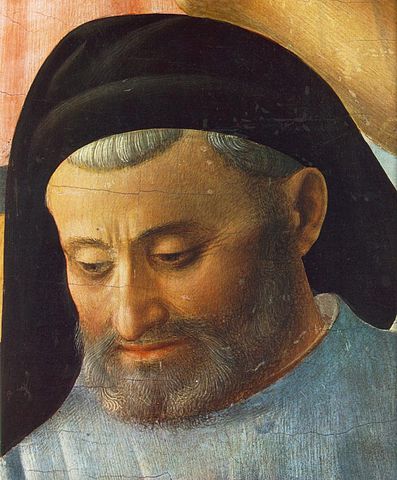
According to Vasari, Fra Angelico initially received training as an illuminator, possibly working with his older brother Benedetto who was also a Dominican and an illuminator. The former Dominican convent of San Marco in Florence, now a state museum, holds several manuscripts that are thought to be entirely or partly by his hand. The painter Lorenzo Monaco may have contributed to his art training and the influence of the Sienese school is discernible in his work. He had several important charges in the convents he lived in but this did not limit his art, which very soon became famous. According to Vasari, the first paintings of this artist were an altarpiece and a painted screen for the Charterhouse (Carthusian monastery) of Florence; none such exist there now.
From 1408 to 1418, Fra Angelico was at the Dominican friary of Cortona, where he painted frescoes, now mostly destroyed, in the Dominican Church and may have been assistant to Gherardo Starnina or a follower of his. Between 1418 and 1436 he was at the convent of Fiesole, where he also executed a number of frescoes for the church and the Altarpiece, which was deteriorated but has since been restored. A predella of the Altarpiece remains intact and is conserved in the National Gallery, London, and is a great example of Fra Angelico’s ability. It shows Christ in Glory surrounded by more than 250 figures, including beatified Dominicans.
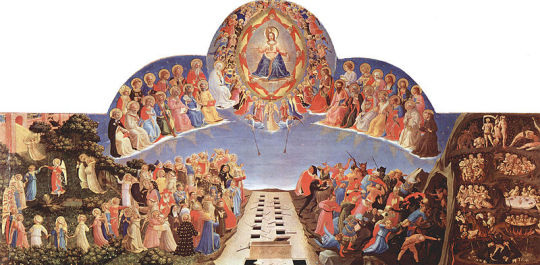
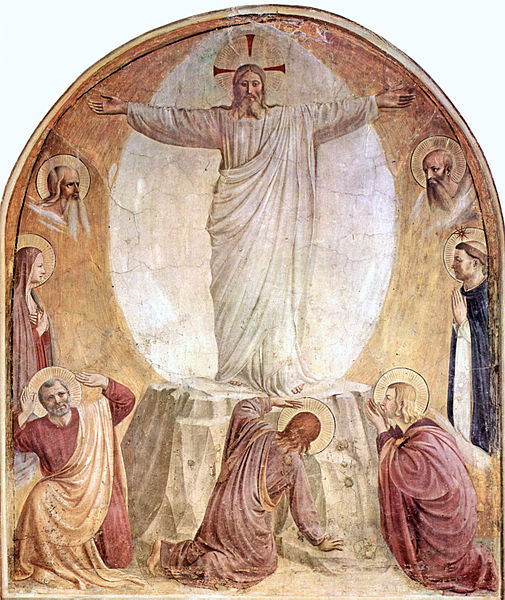
The Last Judgement and The Transfiguration shows the directness, simplicity and restrained palette typical of these frescoes. Located in a monk’s cell at the Convent San’ Marco and intended for private devotion.
San Marco, Florence, 1436–1445
In 1436, Fra Angelico was one of a number of the friars from Fiesole who moved to the newly built convent or friary of San Marco in Florence. This was an important move which put him in the centre of artistic activity of the region and brought about the patronage of one of the wealthiest and most powerful members of the city’s governing authority, or “Signoria” (namely Cosimo de’ Medici), who had a cell reserved for himself at the friary in order that he might retreat from the world.
It was, according to Vasari, at Cosimo’s urging that Fra Angelico set about the task of decorating the convent, including the magnificent fresco of the Chapter House, the often-reproduced Annunciation at the top of the stairs leading to the cells, the Maesta (or Coronation of the Madonna) with Saints (cell 9) and the many other devotional frescoes, of smaller format but remarkable luminous quality, depicting aspects of the Life of Christ that adorn the walls of each cell.
In 1439 Fra Angelico completed one of his most famous works, the San Marco Altarpiece at Florence. The result was unusual for its time. Images of the enthroned Madonna and Child surrounded by saints were common, but they usually depicted a setting that was clearly heaven-like, in which saints and angels hovered about as divine presences rather than people. But in this instance, the saints stand squarely within the space, grouped in a natural way as if they were able to converse about the shared experience of witnessing the Virgin in glory. Paintings such as this, known as Sacred Conversations, were to become the major commissions of Giovanni Bellini, Perugino and Raphael.

San Marco Altarpiece
The Vatican, 1445–1455
In 1445 Pope Eugene IV summoned him to Rome to paint the frescoes of the Chapel of the Holy Sacrament at St Peter’s, later demolished by Pope Paul III. Vasari claims that at this time Fra Angelico was offered the Archbishopric of Florence by Pope Nicholas V and that he refused it, recommending another friar for the position. The story seems possible and even likely. However, if Vasari’s date is correct, then the pope must have been Eugene IV and not Nicholas, who was elected Pope only on 6 March 1447. Moreover, the archbishop in 1446–1459 was the Dominican Antoninus of Florence (Antonio Pierozzi), canonised by Pope Adrian VI in 1523. In 1447 Fra Angelico was in Orvieto with his pupil, Benozzo Gozzoli, executing works for the Cathedral. Among his other pupils were Zanobi Strozzi.
From 1447 to 1449 Fra Angelico was back at the Vatican, designing the frescoes for the Niccoline Chapel for Nicholas V. The scenes from the lives of the two martyred deacons of the Early Christian Church, St Stephen and St Lawrence may have been executed wholly or in part by assistants. The small chapel, with its brightly frescoed walls and gold leaf decorations gives the impression of a jewel box. From 1449 until 1452, Fra Angelico returned to his old convent of Fiesole, where he was the Prior.
Death and beatification
In 1455, Fra Angelico died while staying at a Dominican convent in Rome, perhaps on an order to work on Pope Nicholas’ chapel. He was buried in the church of Santa Maria sopra Minerva.
When singing my praise, don’t liken my talents to those of Apelles.
Say, rather, that, in the name of Christ, I gave all I had to the poor.
The deeds that count on Earth are not the ones that count in Heaven.
I, Giovanni, am the flower of Tuscany.
— Translation of epitaph
The English writer and critic William Michael Rossetti wrote of the friar:
“From various accounts of Fra Angelico’s life, it is possible to gain some sense of why he was deserving of canonisation. He led the devout and ascetic life of a Dominican friar and never rose above that rank; he followed the dictates of the order in caring for the poor; he was always good-humoured. All of his many paintings were of divine subjects and it seems that he never altered or retouched them, perhaps from a religious conviction that, because his paintings were divinely inspired, they should retain their original form. He was wont to say that he who illustrates the acts of Christ should be with Christ. It is averred that he never handled a brush without fervent prayer and he wept when he painted a Crucifixion. The Last Judgement and the Annunciation were two of the subjects he most frequently treated.”

The Crucified Christ
Pope John Paul II beatified Fra Angelico on 3 October 1982 and in 1984 declared him patron of Catholic artists.
“Angelico was reported to say “He who does Christ’s work must stay with Christ always”. This motto earned him the epithet “Blessed Angelico” because of the perfect integrity of his life and the almost divine beauty of the images he painted, to a superlative extent those of the Blessed Virgin Mary.”— St Pope John Paul II


(via AnaStpaul – Breathing Catholic)
33 notes
·
View notes
Photo

Saint of the Day – 18 February – Blessed FRA ANGELICO O.P. (1395-1455 aged 59) – Patron of Artists.
Fra Angelico was an Early Italian Renaissance painter described by Vasari in his Lives of the Artists as having “a rare and perfect talent”.
He was known to contemporaries as Fra Giovanni da Fiesole (Brother John of Fiesole) and Fra Giovanni Angelico (Angelic Brother John). In modern Italian he is called il Beato Angelico (Blessed Angelic One); the common English name Fra Angelico means the “Angelic friar”.
His Transfiguration above, shows the directness, simplicity and restrained palette typical of these frescoes. Located in a monk’s cell at the Convent San’ Marco, its apparent purpose is to encourage private devotion.
In 1982 Pope John Paul II proclaimed his beatification in recognition of the holiness of his life, thereby making the title of “Blessed” official. Fiesole is sometimes misinterpreted as being part of his formal name, but it was merely the name of the town where he took his vows as a Dominican friar and was used by contemporaries to separate him from others who were also known as Fra Giovanni. He is listed in the Roman Martyrology as Beatus Ioannes Faesulanus, cognomento Angelicus—”Blessed Giovanni of Fiesole, surnamed ‘the Angelic’ “.
Fra Angelico is probably better known as an artist than as a holy man. He was already called “Beato” while he was still alive. Pope John Paul II gave this a new reality when he beatified him in 1982. Patrick Duffy tells his story.
Early life
Born Guido di Pietro at Vicchio, 25 kms north-east of Florence, also the birth place of Giotto, in his childhood he was known as Guido da Vicchio or Guido di Pietro. He may have been already a painter before he and his brother Benedetto joined the Dominicans at Fiesole.
At Fiesole 1418-35
After his novitiate at Cortona he went to live at the Dominican convent at Fiesole. As a young friar, he worked at illuminating missals and manuscripts. He became known to his companions as Fra Giovanni da Fiesole but later more popularly – even within his own lifetime in Italy – he was called Il Beato Angelico.
San Marco, Florence (1436-45)
In 1436 Fra Angelico was one of a number of the monks from Fiesole who moved into the newly-built monastery of San Marco in Florence. This not only put him in the centre of artistic activity but also engaged the patronage of the wealthy and powerful Cosimo de’ Medici, who often came there himself when he wanted to retreat from the world.
According to his biographer Giorgio Vasari (1511-74), it was at Cosimo’s urging that Fra Angelico undertook the task of decorating the monastery, including the magnificent Chapter House fresco, the often-reproduced Annunciation, the Maesta with Saints Cosmas and Damian, Saint Mark and Saint John, Saint Lawrence and three Dominicans, Saint Dominic, Saint Thomas Aquinas and Saint Peter Martyr.
The Vatican and Orvieto, 1445–1449
In 1445 Pope Eugenius IV (1431-47), who knew the artist’s work in Florence, summoned Angelico to Rome to paint the frescoes of the Chapel of the Holy Sacrament at St Peter’s but this was destroyed a century later when Pope Paul III (Alessandro Farnese 1534-49) wanted to make room for the great staircase of the Vatican Palace. Vasari says that at this time Eugenius offered Fra Angelico the archbishopric of Florence, but that he refused it, recommending another friar for the position.

In 1447 when the papal court moved to the comparative cool of Orvieto Fra Angelico worked with his pupil, Benozzo Gozzoli, on the vault of the chapel of the Madonna of St Brizio in the cathedral.
In 1449 back at the Vatican, he designed the famous fresco scenes from the lives of St. Laurence and St. Stephen for the walls of the Chapel of Nicholas V. From 1449 until 1452, Fra Angelico was back at San Marco in Florence, where he was prior for three years.
Death and influence
In 1455 Fra Angelico died while staying at a Dominican Convent in Rome, perhaps working on Pope Nicholas’ Chapel. His tomb can be seen in the Church of Santa Maria sopra Minerva in the centre of Rome. And this is his epitaph:
When singing my praise, do not say I was another Apelles.
But say that, in the name of Christ, I gave all I had to the poor.
Part of my work remains on earth and part is in heaven.
The city that bore me, Giovanni, is the flower of Tuscany.
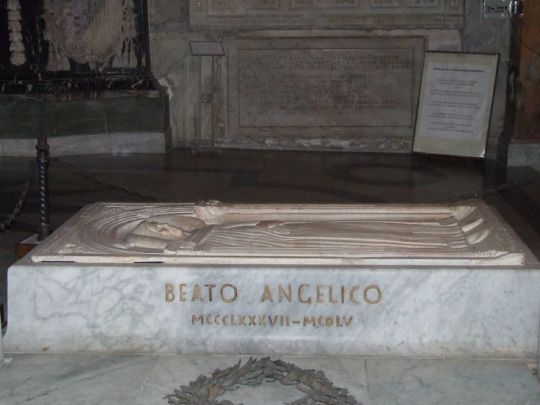

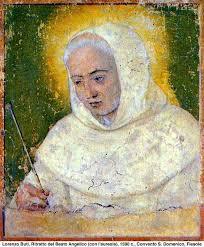

6 notes
·
View notes